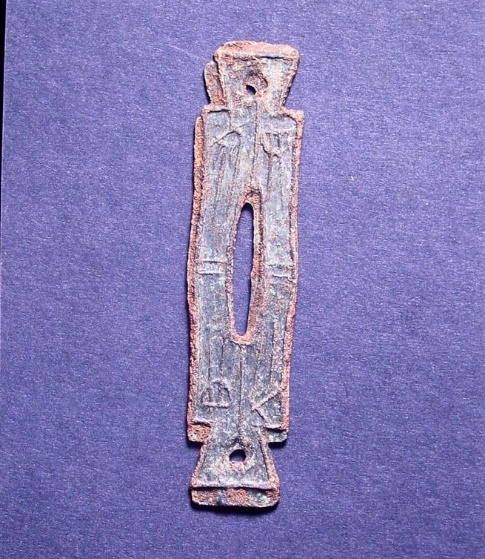Quadrupled Coins Inscribed-The Capital Museum

State of Chu during the final days of the Warring States Period (475-221 BCE)
Total length 9 cm, width 2.1 cm, weight 15 grams
Each of the coin has the form of two coins, one right side up and one upside down, joined at their pointed lower corners. Their small, flat-stemmed, square-shouldered shape is rare. They were cast in two-part molds, and in both of them, the two parts of the mold shifted during casting, so at top and bottom of the coin the two sides are out of register. One end of the coin is inscribed "Four Coins"(四布) while the other is inscribed "Equivalent [of one] Jin " (当釿). Coins of this kind circulated in the Beibi area of the State of Chu during the late Warring States period. Few have ever been unearthed, so these examples are rare and valuable.
During the Warring States period, Chu was the only state that issued coins of cast gold, silver, and copper. For its copper coins, there were two standard types, big and small. The big copper coin displayed the four characters "Shi Currency Jin Equivalent"(旆钱当釿) at the top. Characters at the bottom were interpreted as "Ten Huo"(十货) by previous scholars, while contemporary scholars interpret them as "Seven Dian (七颠)" or "Seven Shen (七慎)". Influenced by the coin shape circulating in central China, the big coin is rectangular and flat-stemmed, with a square shoulder and foot. The little coin is also termed quadrupled coins as related above. Experts believe that the quadrupled coins were a local currency that was cast and circulated in the border counties of the State of Chu after it occupied the Huaihe, Sishui regions and Wuyue regions, thus having a limited circulation.
Why are these coins coupled at the feet? Li Xueqin holds that a half jin could have been easily obtained by breaking the coupling. The broken half weighs 7.5 to 8 grams, and 15 to 16 grams when combined, similar to the "Half Jin" and "One Jin" coins used in the State of Wei. Therefore, the big copper coin, quadrupled coin, and half-quadrupled coin provide three currency values, i.e. two jin, one jin, and half a jin. Chu and Wei shared a border, so these corresponding currency values were favorable to trade and circulation.
